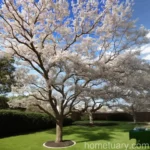Holm Oak (Quercus ilex): A Comprehensive Guide
Plants play a crucial role in the world’s ecosystems, providing oxygen, food, and shelter for numerous organisms. Within the vast and diverse realm of plant species, the holm oak (Quercus ilex) stands out as an emblematic evergreen tree with a wide array of cultural, ecological, and practical uses. This article delves into the intriguing world of the holm oak, exploring its characteristics, cultivation, uses, as well as its significance in various aspects of human life and natural ecosystems.
What is Holm Oak (Quercus ilex)?
The holm oak, scientifically known as Quercus ilex, is a species of evergreen oak tree belonging to the family Fagaceae. This tree species is native to the Mediterranean region, where it thrives in diverse habitats, ranging from coastal regions to mountainous areas. The holm oak is characterized by its dense and glossy foliage, which remains green throughout the year, giving it an enduring presence in the landscape. Its botanical name, Quercus ilex, is derived from the Latin word “ilex,” which means “holm oak.”
Notably, the holm oak has garnered immense popularity not only due to its ornamental value but also for its ecological importance, particularly in relation to supporting wildlife and contributing to the preservation of natural habitats. Furthermore, this species has historical and cultural significance in various traditions, symbolizing endurance, strength, and wisdom.
Key Takeaways – Holm Oak (Quercus ilex)
Before delving into the specifics of cultivating and caring for the holm oak, it is important to understand the key takeaways associated with this unique plant species. The following section provides a concise summary of the fundamental aspects of holm oak, encompassing its cultural, ecological, and practical significance.
Culture
The holm oak holds cultural significance in various regions, symbolizing strength, endurance, and wisdom. It has been incorporated into folklore, mythology, and traditional medicine, reflecting its profound impact on human cultures over the centuries.
Uses
From a practical standpoint, the holm oak serves numerous purposes, including timber production, erosion control, and offering shade in urban landscapes. Additionally, its medicinal properties and natural dye potential contribute to its diverse uses.
Water
The holm oak is known for its resilience to drought, making it well-suited for arid and Mediterranean climates. While it can tolerate periods of dryness, it benefits from occasional watering, especially during its establishment phase.
Sunlight
As an evergreen species, the holm oak requires ample sunlight to thrive. It flourishes in full sun, although it can tolerate partial shade, particularly in hotter regions.
Fertilizer
The application of organic fertilizers can enhance the growth and overall health of the holm oak. However, excessive fertilization should be avoided to prevent potential nutrient imbalances.
Soil
The holm oak thrives in well-draining, slightly acidic to neutral soils. It is adaptable to a range of soil types, including sandy and loamy soils.
Pruning
Pruning helps maintain the desirable shape and size of the holm oak. It is recommended to prune the tree during its dormant period to minimize stress and promote vigorous regrowth.
Propagation
The propagation of holm oak can be achieved through various methods, including seed propagation and vegetative propagation. Each approach has its own set of advantages and challenges.
Container Popularity
Holm oak is increasingly being used in container gardening, providing an evergreen element to outdoor spaces such as patios, balconies, and terraces.
Common Diseases
While relatively resistant to diseases, the holm oak can be affected by certain pathogens, such as powdery mildew and oak decline. Timely monitoring and appropriate management are crucial for disease prevention.
Common Pests
The holm oak is susceptible to pests such as oak processionary caterpillars and oak lace bugs, which can pose a threat to the tree’s health.
Botanist’s Tips
Understanding the specific requirements and growth habits of the holm oak is essential for successful cultivation. Attention to detail and proactive care can foster the tree’s vitality and longevity.
Fun Facts
Exploring the intriguing aspects of the holm oak, including its ecological importance, historical significance, and unique characteristics, adds another layer of appreciation for this remarkable tree species.
Now that we have a comprehensive overview of the key takeaways associated with the holm oak, let us delve deeper into each aspect to gain a thorough understanding of this fascinating plant.
Holm Oak (Quercus ilex) Characteristics
The exceptional characteristics of the holm oak contribute to its widespread appeal and ecological importance. Understanding these features is essential for appreciating the unique qualities of this evergreen tree.
Morphology
The holm oak is a large, long-lived tree that can reach heights of up to 25 meters (82 feet) in optimal conditions. It has a dense, rounded crown with dark, glossy leaves that remain green throughout the year. The leaves are leathery, oblong-elliptic in shape, and feature spiny margins, providing the tree with a distinctive appearance.
The bark of the holm oak is grayish-brown and develops deep furrows and ridges with age. This rugged bark enhances the tree’s resilience and provides habitat for various organisms, including lichens and mosses.
Growth Habits
Quercus ilex exhibits a slow to moderate growth rate, producing sturdy, well-branched structures that contribute to its dense crown. Its growth habit allows the tree to withstand winds and adverse weather conditions, making it well-adapted to its native Mediterranean environment.
Ecological Role
As a cornerstone species in Mediterranean ecosystems, the holm oak plays a vital role in preserving biodiversity and supporting various wildlife species. It provides food and shelter for birds, mammals, and insects, contributing to the overall health and resilience of the ecosystem.
Carbon Sequestration
Holm oak trees are proficient at sequestering carbon dioxide from the atmosphere, playing a part in mitigating the impacts of climate change. Their long lifespan and capacity for carbon storage make them valuable assets in efforts to reduce greenhouse gas concentrations.
Wildlife Habitat
The holm oak serves as a vital habitat for numerous wildlife species, including birds, insects, and small mammals. Its dense foliage and abundant acorn production make it a favored refuge for various creatures, fostering a thriving ecosystem within its canopy.
Understanding the characteristics of the holm oak provides a foundation for exploring its cultivation, uses, and ecological significance. Now, let’s delve into the essential aspects of caring for and cultivating this iconic tree species.
Holm Oak Care
Cultivating and caring for the holm oak requires an understanding of its specific environmental needs, maintenance practices, and potential challenges. From soil preferences to pruning techniques, each aspect of holm oak care contributes to the tree’s overall health and vitality.
Planting
When selecting a location for planting holm oak trees, it is essential to consider their eventual size and growth habits. Choose a site with well-draining soil and ample sunlight, ensuring that the tree has sufficient space to develop its crown and roots.
Climate Requirements
Quercus ilex is well-suited to Mediterranean climates, characterized by hot, dry summers and mild, wet winters. It can tolerate a range of temperatures and is resilient to drought once established. It thrives in USDA hardiness zones 7-11, where it experiences minimal risk of frost damage.
Soil Preferences
The holm oak prefers well-draining, slightly acidic to neutral soils. It can adapt to various soil types, including sandy, loamy, and rocky soils. Avoid waterlogged or compacted soils, as they can impede root development and lead to issues such as root rot.
Watering
During the establishment phase, young holm oak trees benefit from regular watering to promote root development. Once established, they exhibit good drought tolerance, although supplemental watering during extended dry periods can support their overall health and vitality.
Sunlight
As an evergreen species, holm oak thrives in full sun, where it can access ample light energy for photosynthesis. While it is well-adapted to sunny conditions, it can tolerate partial shade, particularly in regions with intense heat.
Fertilization
Applying organic fertilizers in spring can provide essential nutrients to holm oak trees, promoting healthy growth and vigor. Choose a balanced fertilizer with a slow-release formulation to avoid excessive nutrient leaching.
Pruning
Pruning plays a critical role in shaping the canopy, promoting air circulation, and removing dead or diseased branches. Prune holm oak trees during the dormant season, avoiding excessive pruning during the growing season to minimize stress.
Disease Prevention
While generally resistant to diseases, holm oak trees can be susceptible to certain pathogens, particularly in the presence of environmental stressors. Monitoring for signs of disease and implementing preventive measures, such as promoting good air circulation, can help safeguard the tree’s health.
Pest Management
Regular inspections for pests, such as oak processionary caterpillars and oak lace bugs, are essential for early detection and management. Implementing integrated pest management strategies can help minimize pest damage while preserving beneficial organisms.
Propagation Methods
The propagation of Quercus ilex can be achieved through various methods, including seed propagation and vegetative propagation. Each approach requires careful consideration of the tree’s reproductive biology and environmental conditions.
Attending to the specific care requirements of holm oak trees is crucial for fostering their vitality and ensuring their long-term resilience. Now, let’s explore the diverse uses of the holm oak, ranging from timber production to medicinal properties.
Holm Oak Uses
The holm oak offers a wide range of practical and ecological uses, reflecting its versatility and significance in various contexts. From cultural symbolism to timber production, its uses encompass diverse aspects of human life and natural ecosystems.
Timber Production
The wood of the holm oak is prized for its durability, strength, and attractive grain patterns. It is utilized in carpentry, furniture making, and construction, where its resilience to moisture and decay is highly valued.
Firewood
Due to its dense structure and slow growth rate, holm oak wood is favored for use as firewood. It burns slowly and produces long-lasting, high-quality heat, making it a preferred choice for heating in residential and agricultural settings.
Medicinal Properties
In traditional medicine, various parts of the holm oak have been used for their medicinal properties. The bark, leaves, and acorns contain compounds with potential therapeutic effects, including anti-inflammatory and astringent properties.
Natural Dye
The tannins present in the bark and leaves of the holm oak can be used to produce natural dyes in shades of brown, providing a sustainable and eco-friendly alternative to synthetic dyes.
Erosion Control
As a resilient and long-lived tree species, holm oak plays a crucial role in stabilizing soil and preventing erosion in environmentally sensitive areas such as hillsides and coastal regions.
Shade Tree
The dense, evergreen foliage of holm oak makes it well-suited for providing shade in urban landscapes, parks, and residential gardens. Its enduring presence and low maintenance requirements contribute to its popularity as a shade tree.
Wildlife Habitat
The holm oak supports a rich diversity of wildlife, providing food, shelter, and nesting sites for numerous species. Its significance as a wildlife habitat underscores its essential role in maintaining ecological balance.
Carbon Sequestration
Holm oak trees sequester significant amounts of carbon dioxide from the atmosphere, contributing to the mitigation of climate change. Their capacity for carbon storage makes them valuable assets in efforts to offset carbon emissions.
The multifaceted uses of the holm oak underscore its value as a sustainable and adaptable tree species, enriching both natural ecosystems and human communities. In addition to its practical uses, the holm oak holds cultural and historical significance, weaving its presence into the fabric of human traditions and beliefs.
Holm Oak Significance
The holm oak holds cultural, historical, and ecological significance, manifesting its enduring impact on human societies and natural environments. By exploring its symbolism, folklore, and ecological contributions, we can gain a deeper appreciation for the timeless significance of this remarkable tree species.
Symbolism
In various cultures, the holm oak symbolizes strength, endurance, and wisdom. Its evergreen foliage and resilient nature have led to its association with longevity and stability, inspiring reverence and admiration.
Folklore and Mythology
The holm oak features prominently in folklore and mythology, where it is often depicted as a sacred or revered tree with mystical qualities. Stories, legends, and rituals associated with the tree reflect its deep connection to human culture and imagination.
Historical Significance
Throughout history, the holm oak has been esteemed for its practical uses, including timber production, firewood, and medicinal properties. Its enduring presence in human settlements speaks to its historical importance and utility.
Sacred Tree
In certain traditions and belief systems, the holm oak is revered as a sacred tree, embodying spiritual significance and serving as a focal point for ceremonies and rituals.
Biodiversity Conservation
The presence of holm oak trees contributes to the preservation of biodiversity, supporting a web of interconnected species and ecosystems. Their ecological significance extends to the maintenance of balanced and resilient natural habitats.
Wildlife Importance
As a habitat and food source for diverse wildlife species, holm oak plays a pivotal role in supporting ecological interactions and promoting the well-being of numerous organisms within its ecosystem.
Historical Landscapes
Holm oak trees often grace historic landscapes, parks, and gardens, adding a timeless elegance and natural grandeur to their surroundings. Their enduring presence enhances the beauty and cultural legacy of these environments.
By embracing the holistic significance of the holm oak, we can deepen our understanding of its role in shaping cultures, landscapes, and ecological dynamics. Its timeless symbolism and practical value resonate across diverse aspects of human life, underscoring its enduring importance.
The profound significance of the holm oak is complemented by an array of intriguing growth habits, ecological interactions, and cultural connections. As we delve into the holistic understanding of this iconic tree species, we gain insight into its ecological functions, historical resonance, and practical contributions to sustainable living.
Holm Oak in Ecology and Ecosystems
In natural ecosystems, the holm oak fosters diverse ecological interactions, influences habitat dynamics, and contributes to the resilience of ecosystems. By examining its ecological roles, we can appreciate the intricate connections that define its place in the natural world.
Habitat Dynamics
Holm oak trees create a rich and complex habitat, providing food and shelter for birds, mammals, insects, and other organisms. Their dense foliage and abundant acorn production support a thriving web of interconnected species within their ecosystem.
Food Web Interactions
As a source of nutritious acorns, the holm oak sustains a variety of wildlife species, including birds, squirrels, and wild boar. Its role in the food web underscores its importance in supporting diverse trophic relationships.
Soil Stabilization
The extensive root system of the holm oak helps stabilize soil, preventing erosion and promoting the formation of stable, healthy soils. This function is crucial for maintaining ecological balance in diverse landscapes.
Climate Resilience
As a species well-adapted to Mediterranean climates, the holm oak contributes to the resilience of ecosystems in the face of climate variability. Its ability to withstand prolonged dry periods and moderate temperatures supports the overall stability of its habitat.
Carbon Storage
Holm oak trees sequester substantial amounts of carbon dioxide, contributing to the long-term storage of carbon in forests and natural landscapes. Their capacity for carbon storage bolsters the role of forests in global carbon cycling.
Biodiversity Hotspots
Areas with significant holm oak cover often harbor high levels of biodiversity, showcasing the tree’s contribution to biodiversity hotspots and the preservation of unique species assemblages.
Ecological Succession
In Mediterranean ecosystems, the holm oak plays a vital role in successional dynamics, serving as a keystone species that influences the composition, structure, and function of plant communities over time.
By integrating into the ecological fabric of natural landscapes, the holm oak emerges as a linchpin of ecological stability, fostering biodiversity, preserving habitats, and mitigating environmental pressures. Its contributions to ecosystem resilience underscore its essential role in sustaining healthy and vibrant natural environments.
Holm Oak Landscaping and Urban Environments
In addition to its ecological significance, the holm oak holds practical value in landscaping and urban environments, where it offers aesthetic appeal, functional benefits, and sustainable solutions for diverse outdoor settings. By examining its applications in landscaping and urban greening, we can appreciate its adaptive qualities and enduring charm.
Aesthetic Appeal
The glossy evergreen foliage and majestic silhouette of the holm oak make it a favored choice for landscaping, adding year-round visual interest and natural beauty to outdoor spaces.
Urban Greenery
As cities and urban areas embrace green infrastructure, the holm oak emerges as a resilient and adaptable tree species suitable for urban greening initiatives. It thrives in diverse urban environments, contributing to air quality, shade provision, and aesthetic rejuvenation.
Street Trees
Holm oak trees are well-suited for street planting and urban avenues, where they provide a durable, low-maintenance green element that enhances the urban streetscape and fosters a connection to nature.
Parks and Gardens
In public parks, botanical gardens, and private landscapes, holm oak trees contribute to the creation of tranquil, shaded environments that promote recreational activities and community well-being.
Wildlife Corridors
In urban and peri-urban settings, holm oak trees function as wildlife corridors, connecting fragmented habitats and fostering ecological connectivity for diverse species, including birds and insects.
Climate Adaptability
The adaptability of the holm oak to a range of climates and soil conditions makes it a valuable asset in urban landscaping, where it can thrive in diverse settings and contribute to sustainable urban ecosystems.
Shade Provision
As a shade tree, the holm oak offers relief from the heat and sun, creating cool, inviting spaces for outdoor gatherings, leisure activities, and urban respite.
By embracing the adaptive qualities and diverse applications of the holm oak in landscaping and urban environments, we recognize its capacity to enhance the livability, sustainability, and natural beauty of urban settings. Its role in urban greening aligns with the broader goal of fostering resilient, nature-rich cities that benefit human and environmental well-being.
Holm Oak Conservation and Restoration
In light of its ecological importance and cultural significance, the conservation and restoration of holm oak habitats are crucial for preserving biodiversity, mitigating environmental degradation, and safeguarding the future of this iconic tree species. By exploring efforts in conservation and restoration, we can appreciate the collective initiatives aimed at protecting the holm oak and its ecosystems.
Habitat Protection
Preserving and protecting holm oak habitats, including forests, woodlands, and natural landscapes, is essential for maintaining the ecological integrity and biodiversity of these environments.
Reforestation Initiatives
Restoring degraded landscapes and promoting the re-establishment of holm oak trees through reforestation projects contributes to environmental sustainability and habitat recovery.
Invasive Species Management
Managing invasive plant species and mitigating their impact on holm oak habitats is critical for preventing habitat degradation and preserving the unique ecological characteristics of these environments.
Conservation Networks
Establishing conservation networks and protected areas that encompass holm oak habitats and associated ecosystems fosters the long-term preservation of biodiversity and ecological processes.
Education and Outreach
Raising awareness about the ecological importance of the holm oak and its associated ecosystems through education and outreach initiatives enhances public engagement and support for conservation efforts.
Sustainable Land Management
Implementing sustainable land management practices that prioritize the conservation of holm oak habitats and their associated biodiversity strengthens the resilience and vitality of natural landscapes.















